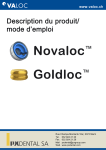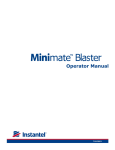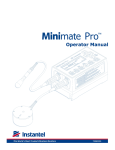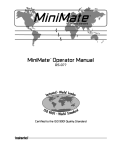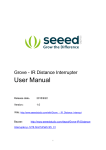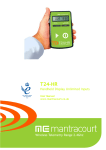Download 801U0701 rev 05 Locator User Manual
Transcript
INSTANTEL INC. KANATA, ONTARIO 613-592-4642 DISTRIBUTOR Name_________________________ Address_______________________ Telephone_____________________ Locator User Manual 801U0701 Rev 05 © INSTANTEL INC., 1994-1999 309 Legget Drive Kanata, Ontario Canada K2K 3A3 Tel: (613) 592-4642 Fax: (613) 592-4296 Instantel, the Instantel logo, and WatchMate are registered trademarks of Instantel Inc. in North America Printed in Canada -1Locator User Manual Warranty Instantel’s products are warranted against defects in materials and workmanship and shall perform in accordance with published specifications for a period of one year. Statements United States - FCC The WatchMate system complies with Part 15 of the FCC rules. Operation is subject to the following two conditions: (1) This device may not cause harmful interference, and (2) this device must accept any interference received, including interference that may cause undesired operation. Changes or modifications to the equipment not expressly approved by Instantel could void the user’s authority to operate the equipment under Part 15 of the FCC Rules. Canada - Industry Canada This device complies with RSS-210 of Industry Canada. Operation is subject to the following two conditions: (1) this device may not cause interference, and (2) this device must accept any interference, including interference that may cause undesired operation of the device. New Zealand - Ministry of Commerce This device meets the requirements of specification RFS 29 under Regulation 43 of the Radio Communications (Radio) 1993 regulations. Japan - MPT This device meets the requirements of Paragraph 6-1-1 of the Electric Wave Act, May 27, 1989. Limitation of Liability This Product has been designed for use to reduce the risk of resident wandering through remote detection. The range, accuracy, function and performance of this Product may vary from the published specifications due to many factors, including, without limitation, site impairments from structural effects, metal objects in the vicinity, placement of the receiver and transmitter, interference from other electrical devices, atmospheric effects, installation, and maintenance. There may be other factors which also affect performance of this Product. Instantel does not guarantee that this Product will detect 100% of resident wandering nor does Instantel guarantee that this Product will not return false reports of resident wandering. Monthly testing and maintenance of this Product, as described in the Product documentation, is essential to verify the system is operating correctly and to ensure that the probability of detecting an alarm and locating the transmitter are maximized. The failure to undertake regular testing and maintenance will increase the risk of system failure and failure to report resident wandering. Instantel hereby disclaims all warranties, express or implied, arising out of or in connection with any of its Products of the use or performance thereof, including but not limited to, where allowable by law, all other implied warranties or conditions of merchantable quality and fitness for a particular purpose and those arising by statute or otherwise in law or from a course of dealing or usage of trade. Instantel’s liability to you or anyone claiming through or on behalf of you with respect to any claim or loss arising out of the use or misuse of Instantel’s Product, defective products or materials, improper installation or maintenance of Instantel’s Product or products or the system in which they are incorporated, or alleged to have resulted from an act or omission of Instantel or any person, negligent or otherwise, shall be limited to: a. The repair or replacement of defective Product or materials supplied by Instantel during the warranty period as set out in the Product documentation; or, at the option of Instantel, b. Refund of the purchase price of the Product supplied by Instantel. In no event shall Instantel be liable for general, specific, indirect, consequential, incidental, exemplary or punitive damages or any losses or expenses suffered by you or anyone else, whether or not Instantel, or its employees, officers, agents, resellers or installers has been informed of the risk of such loss or expense and whether or not such losses or expenses were foreseeable. -2Locator User Manual Table of Contents General Notes .................................................................................................................5 Locator Menu Items ......................................................................................................5 Locating Techniques Outdoors.....................................................................................7 Locating Techniques Indoors .......................................................................................8 Reflections and Blocking of the Main Signal...............................................................8 APPENDIX.....................................................................................................................10 LOCATOR SPECIFICATIONS ..................................................................................13 -3Locator User Manual -4Locator User Manual General Notes 1.1 The Locator can be used to find a specific WatchMate™ Transmitter based on the Transmitter's ID number. The Locator can also be set to detect any WatchMate Transmitter, regardless of the ID number. Locating a Transmitter can be done indoors with either the Yagi antenna supplied with the unit or a Sensor antenna as used with a WatchMate Doorpack. Outside, maximum range is best attained with the Yagi antenna. Locating techniques are discussed in section 3.0. 1.2 Backlighting of the display can be used at any time but battery power can be conserved by turning it off, providing longer search time if needed. 1.3 Generally, the distance at which a Transmitter can be decoded is less than the distance at which it can be heard in the headphones. This is especially true if one often practices listening to a Transmitter at some distance. Locator Menu Items 2.1 The various Locator User menus are shown in Figure 1. ID#=ALL T=060 S=XXX SIG= >< KEYS SHORT BEEP USE ><=CHANGE *=SAVE >< KEYS *=SAVE SOUND OFF USE ><=CHANGE *=SAVE MAIN MENU The decode threshold can be set to values other than 60 using the up/down arrow keys in this menu. To set the desired ID #, simply enter it. >< KEYS BEEP=SIGNAL STRENGTH USE ><=CHANGE *=SAVE BEEPER SOUND MENUS To set the beeper sound operation, simply select the appropriate menu with the left or right arrow keys, then press *. You will then be back in the MAIN menu. SPECIFY ID#: 0 0=ALL,PRESS *=RETURN Figure 1. Locator Menus -5Locator User Manual ID SELECTION MENU If you wish to decode any valid Transmitter, enter 0. If a specific ID # is desired, enter that number. The left arrow key can be used as DELETE key here. Pressing * once the selection is made returns you to the MAIN menu above. 2.2 This is the menu seen upon turning on the Locator. The ID number of the Transmitter being looked for, the signal strength threshold, "T", the received signal strength, "S" and a bar graph representation of the "S" value are presented. Values for each item appear whenever a selected Transmitter is decoded. Instead of selecting one specific Transmitter, any ID number may be decoded and displayed when "ALL" is selected by entering a "0". 2.3 In all menus used, "S" represents the received signal strength, ie. the strength of the signal detected by the receiver in the Locator. In all menus used, "T" represents the threshold level over which the "S" value must exceed to get the Locator to decode the Transmitter. 2.4 To adjust the threshold value, simply press either the up or down arrow key. The higher the value, the closer a Transmitter must be to be decoded and displayed. 2.5 Pressing a left or right arrow in the MAIN menu brings up one of the sound menus, SHORT BEEP, BEEP=SIGNAL STRENGTH or SOUND OFF, . To select any one of these menus, simply use the left or right arrow keys again to display the desired menu and press the * key to enter it. 2.6 The SHORT BEEP menu allows you to hear a short beep whenever a selected Transmitter is decoded and displayed, regardless of its signal strength (provided it is above the "T" threshold setting). This setting is useful if only direction is important and not distance, as when used indoors. 2.7 The BEEP=SIGNAL STRENGTH menu allows you to hear a longer and longer beep as the signal strength goes up. This means that as you get closer to the Transmitter, the beep length will increase. This menu is useful when locating a Transmitter outdoors so that you need not look at the display to determine that you are getting closer. 2.8 As with regular WatchMate Monitors, a MAINTENANCE mode exists in the Locator. This mode allows you to set additional parameters when using a Locator, such as turning ON and OFF the backlighting of the display, adjusting the amount of noise that is acceptable on the data being decoded, etc. More details on these menus is given in section in the appendix. -6Locator User Manual Locating Techniques Outdoors 3.0 When the Locator is needed to find someone outdoors, locate the exit door used by the patient and start the sweep there. Have someone accompany you to assist in watching for moving vehicles (if searching near a road) while you are busy listening for the Transmitter. Caution should be observed when handling the Yagi antenna to not poke someone with its elements. An illustration of a Yagi antenna is shown in Figure 2. BACK FRONT BOOM BACK ANTENNA CABLE FRONT HANDLE Figure 2. Yagi antenna illustrating vertical (top) and horizontal (bottom) polarization. 3.1 Ensure the antenna cable is well connected to the antenna and the Locator. Make sure the decode threshold is at about 60 on the MAIN menu. The higher the threshold, the closer the Transmitter must be to be decoded. If the Threshold is set too low, the unit will be busy trying to decode noise and may miss a real Transmitter signal. The * key will save the current threshold setting so it can be used again when the unit is turned on next time. 3.2 Set the ID of the Transmitter being looked for, if known, so that all others will not be displayed. This is done in the MAIN menu simply by entering the number directly. Follow the instructions on the display. 3.3 Once outside with the Locator, do a 360° sweep (if you have no idea of which direction the wanderer has gone) with the antenna held such that the elements are vertically positioned (see figure 2, Vertically polarized position). 3.4 First, see if the Transmitter signal can be decoded by the Locator. If the signal is strong enough, the unit will start to beep once approximately every half second. Each beep corresponds to one transmission of the Transmitter. Some transmissions may be missed due to the movement of the Transmitter or other objects in the path between the Transmitter and Locator. -7Locator User Manual 3.5 If the Transmitter cannot be located immediately, try another 360° sweep with the antenna held such that the elements are horizontally positioned (see figure 3, Horizontal polarization position). NOTE: the front of the antenna is at the end which has the shortest of the 4 elements - the antenna cable runs off the back end of the antenna. 3.6 If still unable to detect the desired Transmitter, plug in the headphones and listen for the distinctive "thumping" sound of a Transmitter. To distinguish this sound from other possible noises, a Transmitter produces a regular "heartbeat" type of sound about every half second. The volume control can be found on the headphone cable. The antenna can be held by the handle or at the back end of the boom - best performance will be achieved by holding the antenna as far from your body as possible. 3.7 When close to the facility, the majority of the sounds may come from inside the building (from other patients) so try to move away from the building somewhat until only the wandering patient's Transmitter can be heard if you are sure that the wanderer is outside. Locating Techniques Indoors 4.1 The same information above applies to locating someone indoors except that the number of reflections can be much greater, thereby causing more fluctuations (holes and peaks) in the signal pattern. 4.2 To facilitate the locating operation indoors, the WatchMate Sensor antenna can be used instead of the Yagi antenna. The back of the Sensor antenna is identified by a label. When using this antenna, best performance is obtained by holding it at its center. Again, vertical or horizontal polarization can be used. Try both. 4.3 The threshold setting should be set higher indoors than normally used outdoors. A search, corridor by corridor will be more effective in finding a Transmitter than standing in one part of the building, such as the lobby, and trying to locate someone on the third floor. Reflections and Blocking of the Main Signal 5.1 Sometimes when locating a Transmitter outdoors, terrain or objects may block the direct path of the signal from the Transmitter to the Locator. In such cases, the signal may bounce off nearby buildings (aluminum siding), cars or other metallic objects. These misleading signals may not point you in the right direction at first but should be used since they may be all you have to go on. Thus, it is important to move often with the Locator to "follow" the signal, especially if the wanderer is moving a lot or is in a location with many reflective metallic objects. 5.2 In trying to find the wanderer, continue to vary the antenna orientation between vertical and horizontal polarization. This should be done to maximize the received signal -8Locator User Manual since the orientation of the Transmitter can have an effect on the level of the received signal. The information above also applies to indoor searches. Electrical Noises and Interference 6.1 Electrical noises in the atmosphere will be heard from time to time. These are produced by car ignition systems, hydro transformers, high power communication transmitters and commercial broadcast stations. Some or all of these sources of interference may increase the difficulty in finding the wandering patient. To combat these interferences, try to stay away from vehicles that are running (even idling), hydro lines, cellular phones and other communication radios. Also try rotating the antenna along its main boom axis from vertical to horizontal polarization until the Transmitter can be heard more clearly. Practice, Practice, Practice... 7.1 To be successful in finding someone in a crisis situation, practice beforehand is imperative. Therefore, try out the Locator from time to time to keep in practice in using it and becoming accustomed to hearing strange environmental noises that exist outside. 7.2 To practice, start by listening to a Transmitter in close proximity (less than 20 feet) outside, away from the building. Listen for the repetitive "heart" beat of the Transmitter and become familiar with it in the presence of noise you might encounter. 7.3 Try to slowly increase your distance from the Transmitter and note how the loudness of the thumping decreases. The surrounding terrain and/or buildings may have some effect on the distance at which you can hear the Transmitter, so experiment and observe these effects in the area in which the Locator will be used. The more familiar you are with the performance of the Locator in your area, the faster you will be able to locate a wanderer should you need to do so. -9Locator User Manual APPENDIX ADVANCED MAINTENANCE MENUS To access the Maintenance menus, press the ? key, followed by 7890 followed by the * key. Use the up and down arrows to scroll through the available menus. Use the * key to enter a given menu. The available menus and their meaning are explained below. To exit any menu without changing its values, press the "0" key. To exit back to the MAIN menu, press the "0" key. Unless stated otherwise, all values displayed are in counts, from 0 to 255. This is due to the 8 bit nature of the microcontroller used in the Locator. LCD BACKLIGHT This menu allows you to turn ON and OFF the backlight. By entering the menu with the * key and using the up or down arrow keys, you can toggle the backlight on or off. To save the setting, exit the menu with the * key. With the backlight off, the current draw of the Locator is about half what it is with it on and therefore, doubles the operating time. In bright sunlight, it can be difficult to tell whether the backlight is on or not, so use this menu to ensure it is off if maximum operating time is desired. ID CAPTURE AND DISPLAY This menu allows you to display the ID number, the signal strength threshold, "T", the received signal strength, "S" and the data level parameters of a given Transmitter. This menu can be used as a diagnostic aid to find out what the ID number is of a given Transmitter. This menu can also be used to preset the signal strength threshold to some value which will be used every time the unit is turned on. This menu has three sub-menus as described in the following pages in "DATA POSITION MENU","SIGNAL STRENGTH RIPPLE MENU" and "ANALYSIS SUMMARY MENU". To set the threshold level to some value, press the up or down arrow key. To save the threshold setting, press the * key. To not save the value, press the "0" key - the old threshold value will be used instead. A parameter called RSSI (Received Signal Strength Indication) appears in this menu. It displays the same information as does the "S" signal strength parameter, except in units of dBm (dB with respect to one mW). This is similar to referring to temperatures in units of degrees Celsius instead of degrees Farenheit. The RSSI value is derived from the "S" value and is calibrated at the factory. The RSSI value can be used in conjunction with a second sub-menu, DATA POSITION, to determine the relative position of a Transmitter's frequency within the Locator's receiver window. This sub-menu is described below and can be used to verify proper Transmitter operation. - 10 Locator User Manual The values for the ID number, RSSI and signal strength are displayed whenever a Transmitter is decoded successfully. These values are then held temporarily and displayed until the update from the next transmission. DATA POSITION MENU To get to this menu, enter the ID CAPTURE AND DISPLAY menu as described above. Once in the menu displaying the RSSI value, press the left or right arrow key and the next menu will display the ID number, the threshold, "T", the signal strength, "S" and two other parameters: Dx and Dn. These last two parameters display the maximum (Dx) and minimum (Dn) positions of the logic "1" and "0" data bits which make up the ID number of the Transmitter. The other parameters are as described previously. To see that a Transmitter is within the receiver's "window", select the ID CAPTURE AND DISPLAY menu first. The threshold should be set to a value between 70 and 100. Next, disconnect the antenna cable from the back of the Locator and hold the Transmitter near the connector on the Locator. The Locator should start to beep with each transmission and the display should show values for the ID number, RSSI and "S" parameters. Now, hold the Transmitter on the connector until an RSSI value of -95 dBm (or close to it) appears on the display. To get this level, you may need to move the Transmitter around on the connector. Note the value of the "S" parameter when you get an RSSI of -95 dBm and press the left or right arrow key. The display will now show the data positions as outlined above. Position the Transmitter near the connector again until the same value for the "S" parameter is showing the value noted. Now read the Dx and Dn values. They should be as follows: Dx: maximum value should be less than or equal to 240. Dn: minimum value should be greater than or equal to 15. SIGNAL STRENGTH RIPPLE MENU To get to this menu, enter the ID CAPTURE AND DISPLAY menu as described above. Once in the menu displaying the RSSI value, press the left or right arrow key twice. The menu will display the ID number, the threshold, "T" and two other parameters: Sx and Sn. These last two parameters display the maximum (Sx) and minimum (Sn) values of the signal strength during a transmission. The other parameters are as described previously. The difference between Sx and Sn gives you the amount of ripple in the received signal strength and is typically 10 or less. ANALYSIS SUMMARY MENU - 11 Locator User Manual To get to this menu, enter the ID CAPTURE AND DISPLAY menu as described above. Once in the menu displaying the RSSI value, press the left or right arrow key three times. The menu will display the ID number, the threshold, "T" and four other parameters: P, A, F and S. The "P" parameter displays the preamble length of a transmission in µs. The "A" represents the received signal strength ripple as described earlier. The "F" parameter displays the peak to peak excursion of the data level - ie. Dx-Dn (see DATA POSITION MENU earlier). As before, "S" is the received signal strength. Pressing the left or right arrow kay returns you to the first menu as described in 1.2 above. RECEIVER DIAGNOSTICS MENU (dBm) This menu allows you to display the average and peak data and received signal strength levels. It is accessed as described in section 1.0. This menu has one sub-menu. Once in the menu, two lines of values are displayed. The top line shows average data "D" and received signal strength "S" levels. The second line shows the peak values for these same two parameters, taken over the length of one transmission, ie. the peak time frame used is the same as that of the length of one transmission period. The value shown for "D" is in counts and the value shown for "S" is in dBm. RECEIVER DIAGNOSTICS MENU (COUNTS) To access this sub-menu enter the RECEIVER DIAGNOSTICS MENU as described in1.0 and press the left or right arrow key. The same menu appears as described in 1.3 above, except that the values of "S" are in counts. Pressing the left or right arrow key again returns you to the previous menu. Pressing the * key exits the menu. DATA NOISE MENU This menu allows you to increase the amount of noise that can be tolerated on the data signal during decoding. It is accessed as described in section 1.0. To enter this menu, press the * key. The up or down arrow keys can be used to set the noise from 8 to 20 counts. You may find that the decoding range is extended slightly with a greater acceptance in noise on the data signal. To save a value for the amount of acceptable noise, press the * key. This will also exit you from this menu. - 12 Locator User Manual LOCATOR SPECIFICATIONS External Input Voltage: 11.5 to 14.0 Volts DC only, 250mA nominal. Operating time: -on battery pack: 8 hours -with backlight on: 4 hours Charge time for battery pack: 16 hours Range: -decoding: up to 400 ft depending on terrain, Transmitter orientation and environmental conditions -audible: up to 600 ft depending on terrain, Transmitter orientation and environmental conditions Operating frequency: 217.003 MHz Bandwidth: 18 kHz Modulation acceptance: FSK, 4 to 6 kHz deviation peak-to-peak. Operating temperature: -10°C to +50°C with internal battery -20°C to +50°C with external source (backlight on) Humidity: 95% non-condensing Dimensions: 5.38"H x 6.92"W x 2.25"D (136mmHx176mmWx57mmD) Locator Weight: approx. 2.0 Lbs (923g) Accessories supplied: Carrying case, rechargeable 1.2Ahr sealed lead acid battery, battery charger, lighter plug & cable, 4 element Yagi antenna with cable, headphones w. in-line volume control, User Manual. - 13 Locator User Manual - 14 Locator User Manual
















